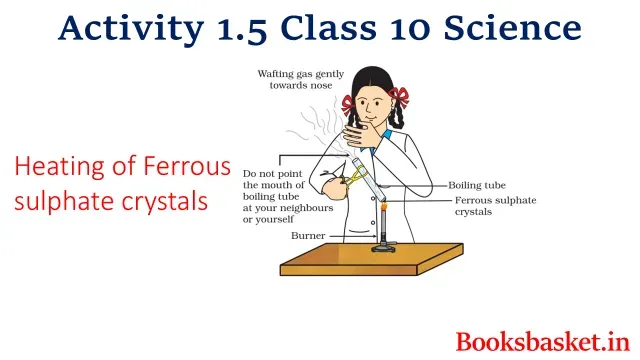Summary
The
heating of Ferrous Sulphate crystals leads to the loss of water of crystallization
and the turning of pale green to white crystals. On further heating, Ferrous
sulphate decomposes into a brown residue of ferric oxide, sulphur dioxide and
sulphur trioxide gases that cause a pungent smell.
Aim of the activity
The aim is to observe the changes that occur when Ferrous sulphate crystals are heated and to study the chemical reaction
Material used in the activity
1. Ferrous sulphate crystals
2. Dry boiling tube
3. Spirit lamp
4. Test tube holder
5. Goggles
Procedure
We will put about 2 grams of Ferrous sulphate crystals in a dry boiling tube, hold the boiling tube with a test tube holder and heat it gently over the flame of the spirit lamp.
Observation
Before Heating
The ferrous sulphate crystals are pale green.
During Heating
Ferrous sulphate crystals have water of crystallization that evaporates during heating so the crystals turn white.
After Heating
After continuous heating, the final residue is brown Ferric oxide (`Fe_2O_3`), and a pungent smell indicates the evolution of gases.
These gases are sulphur dioxide (`SO_2`) and sulphur trioxide (`SO_3`)
Explanation
Step 1: Loss of water of crystallisation
When ferrous sulphate is heated, the water of crystallization evaporates.
`FeSO_4.7H_2O heat →FeSO_4 + 7H_2O`
Due to water loss of crystallization, the pale green crystals turn white.
Step 2: Thermal Decomposition
Now on continuous heating, dry ferrous sulphate (FeSO4) crystals decompose into ferric oxide sulphur dioxide and sulphur trioxide.
`2FeSO_4 →Fe_2O_3 + SO_2 + SO_3`
A pungent smell is observed due to these gases.
Conclusion
In this activity, ferrous sulphate crystals lose their water crystallization and on further heating decompose into ferric oxide sulphur dioxide and sulphur trioxide gases.
This decomposition reaction.
Frequently Asked Question
1. What type of chemical reaction takes place in this activity?
Ans – Thermal Decomposition reaction
2. What is the colour of ferrous sulphate crystals?
Ans- Pale green
3. What is the colour of ferrous sulphate crystals when they are heated?
Ans - White
4. What is the final residue of this chemical reaction?
Ans – Ferric oxide in the solid form and `SO_2` and `SO_3` are gases.
5. What is the smell of the gases that evolved during the reaction?
Ans – The gases have a pungent smell that is suffocating.
6. What is the colour of ferric oxide?
Ans – Brwon
7. What is thermal decomposition?
Ans - The chemical reactions in which a single substance breaks down when they are heated. So energy in the form of heat is required.
Important extra points
1. The chemical formula of ferrous sulphate crystals is `FeSO_4.7H_2O`
2. The reaction in the activity is thermal decomposition and dehydration of hydrated ferrous sulphate crystals.
3. This reaction is used in the production of Ferric oxide.
4. Sulphur dioxide is a pollutant and causes acid rain.
5. Ferric oxide is used in the manufacturing of pigments.
Safety Precautions
1. Always wear safety goggles and gloves.
2. Ensure proper ventilation.
3. Keep your nose away from the gases as these gases are toxic and suffocating.
You can also explore
1. Identification tests for gases that evolved during this activity.
2. Heat other crystals like `CuSO_4.5H_2O`, `Na_2CO_3.10H_2O` etc.
3. Explore physical and chemical changes and note them down in your notebook.
Multiple Choice Questions
1. What is the colour of Ferrous sulphate crystals before heating?
a.White
b.Pale green
c.Brown
d.Black
Correct answer – (b)Pale green
2. What type of chemical reaction takes place when ferrous sulphate is heated?
a.Combination reaction
b.Decomposition reaction
c.Displacement reaction
d.Neutralization reaction
Correct answer – (b) Decomposition reaction
3. What is the final colour of the residue left in this activity?
a.Black
b.Brown
c.Green
d.Yellow
Correct answer- (b) Brwon
4. What gases are evolved during the heating of ferrous sulphate crystals?
a.`CO_2 and H_2`
b.`O_2 and N_2`
c.`SO_2 and SO_3`
d.`Cl_2 and H_2`
Correct answer- (c) `SO_2 and SO_3`
5. What is the chemical formula of ferrous sulphate crystals?
a.`FeSO_4`
b.`FeSO_4.7H_2O`
c.`FeSO_4.5H_2O`
d.`FeO`
Correct answer- (b) `FeSO_4.7H_2O`
6. Why do ferrous sulphate crystals lose their green colour on heating?
a.Due to loss of hydrogen
b.Due to loss of water of crystallization
c.Due to decomposition of ferrous sulphate
d.Due to loss of water of crystallization
Correct answer –(b)Due to loss of water of crystallization
7. What is the residue formed after the decomposition of ferrous sulphate?
a.Ferric oxide
b.Ferric sulphate
c.Ferrous chloride
d.Iron metal
Correct answer – (a) Ferric oxide
8. What is the smell of the gases that evolved during this activity?
a.Odorless
b.Sweet
c.Pungent
d.Fruity
Correct answer – (c) Pungent
9. What happens to the water of crystallization?
a.Gets decomposed
b.Gets evaporate
c.Remains in compound
d.None of them
Correct answer –(b)
10. What type of salt is ferrous sulphate before heating?
a.Anhydrous salt
b.Hydrated salt
c.Basic salt
d.Acidic salt
Correct answer –(b) Hydrated salt
a. `2FeSO_4→ Fe_2O_3 + SO_2 + SO_3`
heat
b. `FeSO_4 → Fe + SO_2 + O_2`
heat
c. `FeSO_4→FeSO_4 + 7H_2O`
heat
d.`FeSO _4 + H_2→ Fe + H_2SO_`4
Related Class 10 Science Activities
S.No. | Topic |
1 | |
2 | |
3 | |
4 | |
5 | |
6 | |
7 | |
8 | |
9 | |
10 | |
11 |

.webp)



No comments:
Post a Comment